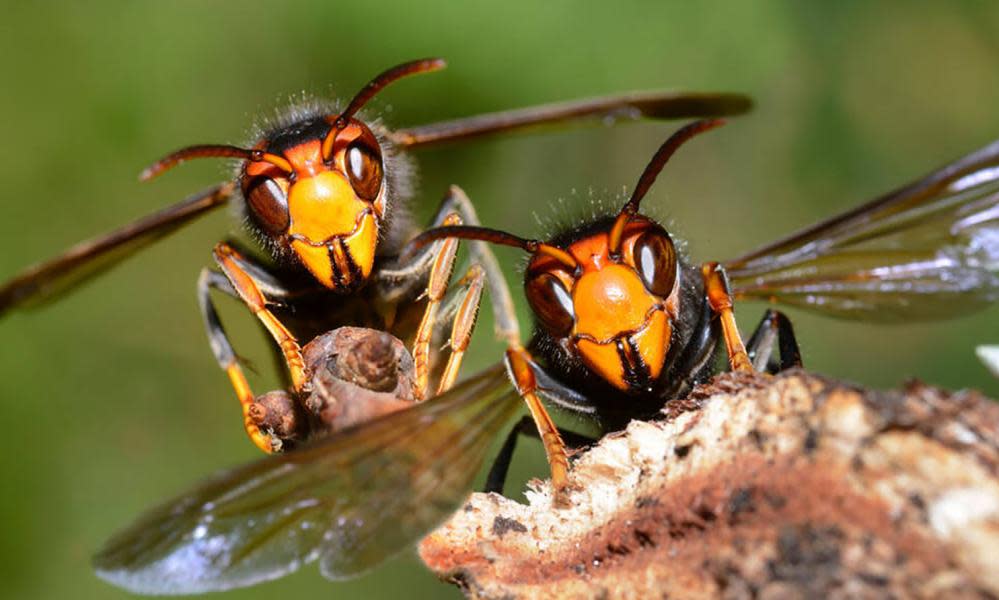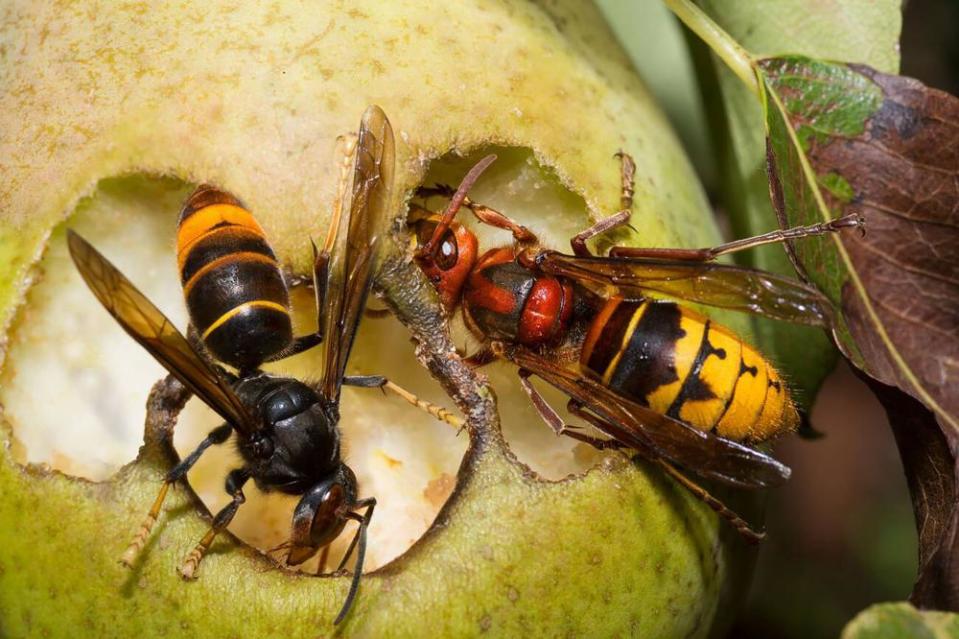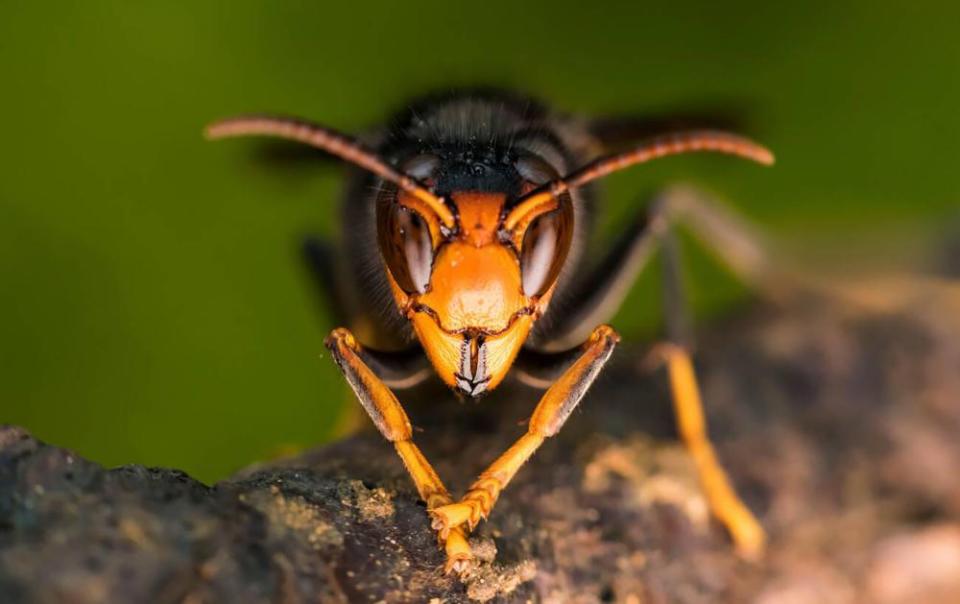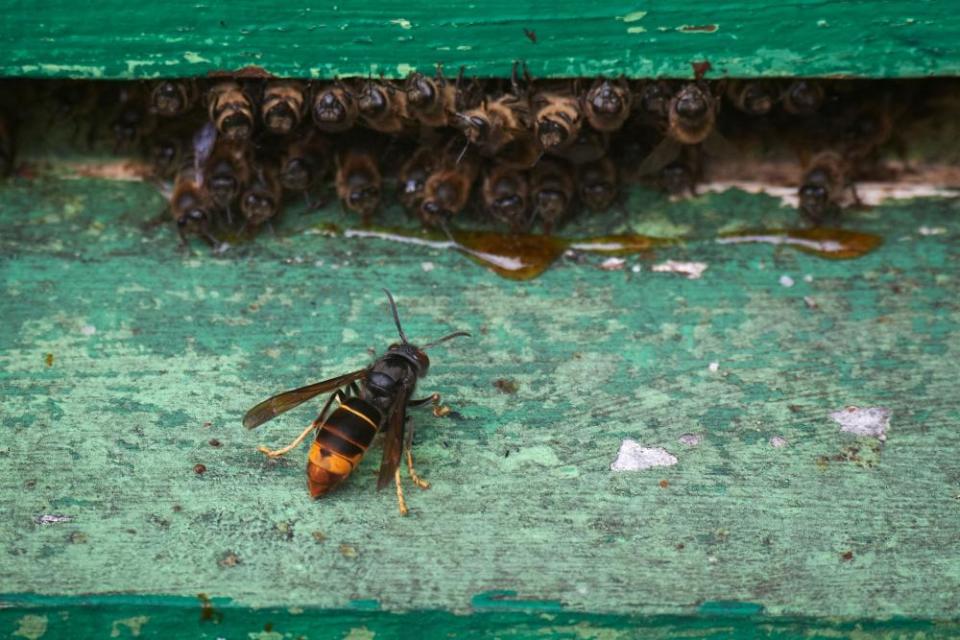Hornet hunters: the crack squad keeping an invasive species at bay on Jersey

John De Carteret has already taken a call about three captured Asian hornets when we meet on a gloriously sunny morning on the Channel Island of Jersey. The retired police forensics detective is the linchpin of the Jersey Asian Hornet Group (JAHG), a band of two dozen volunteers. These mostly retirees are the frontline troops in a seemingly unwinnable war against an invasive foe – a voracious predator of honeybees and all other flying insects, which has rapidly conquered the west European mainland.
But De Carteret, who sports a JAHG polo-shirt and a lanyard showing he is authorised by the government to catch and release Asian hornets (more about the releasing later), is undaunted. “You can’t take your foot off. You’ve got to be dynamic and aggressive. If we get a report, we’re there within half an hour,” he says.
Our first call is to a beautiful garden belonging to Tony and Nicky du Feu. Tony has been checking special hornet traps – a coffee cup-like contraption filled with a sugary lure – that he and his wife have placed around Jersey’s north-east corner. Nicky is fuming because her husband has caught three hornets. “It’s quite addictive and it’s quite competitive,” says Tony of their hornet-hunting. This year so far, they have trapped more than 10% of the 208 (and counting) queens caught across Jersey. “If we don’t achieve 10%, we’re not doing our job,” says Nicky.
The Du Feus hand the traps to De Carteret. Inside one buzzes a slender, mostly black hornet, which is slightly smaller than the yellower native European hornet. The Asian hornet, Vespa velutina, has an orange face, narrow black wings, yellow legs and yellow-and-black stripes on the underside of its rear end. Remarkably, each individual is believed to be descended from one mated queen, which stowed away in plant pots from China bound for Marseille in 2004. Since then, the species has spread rapidly through France and into Spain, Portugal, Switzerland, Germany and Belgium. Britain has only had a few incursions – 23 from 2016-22 and four so far this year, which almost certainly hitched a lift on cross-Channel ferries and lorries. But the Jersey volunteers warn that an invasion is coming.
There is a whiff of racism about an invading “Asian” hornet – hopefully, the species will become known as the yellow-legged hornet – but it appears to be a genuine threat to wildlife, and a voracious predator. As a beekeeper, Du Feu has watched hornets hovering outside the entrance to his hives, picking off worker bees laden with pollen as they return. Hornets create a landscape of fear, the bees stop foraging, and colonies collapse. But they don’t just threaten honeybees: by late summer, their nests are as big as an extremely large watermelon. French researchers estimated that a single nest can consume 11.3kg of insects over its late-summer lifetime.

The economic and human health impacts of the hornets also trouble policymakers: their late-summer search for sugar has been found to damage grapes in Spain, while grape pickers can’t pluck the fruit by hand for fear of getting stung.
Jersey, where the Asian hornet was first spotted in 2016, is seeking to repel the insect. If successful, it could give succour to the worried scientists, beekeepers and officials from all parts of Britain and Ireland who have visited the 46-sq mile island in the hope of finding a way to keep it out. Last year, volunteers working with the government detected and destroyed 174 nests. Of these, 117 were after worker hornets had been tracked through the countryside. “This year will show whether we can keep on top of it,” says Bob Tompkins, another JAHG volunteer who is the only islander so far to lose bee hives to the predator.
Jersey’s efforts to keep the hornet at bay are both low- and hi-tech, ingenious and simple. The hornets overwinter as queens. In spring, these queens emerge and build their first, small nests. France is 14 miles from Jersey’s east coast, and while large numbers of hornets are unlikely to cross the Channel to Britain by flying, they can easily reach the island assisted by east and north-easterly winds.
Every spring and summer, the volunteers must catch the emerging queens before they build nests and their numbers explode. A network of government-funded traps are hung across the island and must be checked every day to remove live bycatch – the last thing the volunteers want to do is kill more flying insects. Each captured queen is put in a freezer to kill it. The body is preserved and pinned by a volunteer researcher – this could be valuable data for future research.
My next stop with De Carteret is to a queen’s early-summer nest, which has been reported as dangling above someone’s front door. “To me, this is like scene-of-crime work – going to one scene after another,” says De Carteret. “It gets you hooked.”
This “embryo” nest is the size of a lightbulb and looks like a pretty paper lantern. We wait for 15 minutes but no hornet appears. There is no point destroying a nest without a queen. So De Carteret will return at dusk and put the little nest into a big container – if the queen is still alive, she will be inside at dusk, and captured.
The key to finding hornets is to inform the public, says De Carteret. Thanks to plenty of media coverage on the island – and his popular Facebook page – many Jersey islanders can now identify them. “People need to know what these insects look like,” says De Carteret. “It’s a big problem but it’s a community problem.”
His mobile rings constantly. The next call is from Jo Burke, who reports a suspected Asian hornet in her utility room on the south edge of the island. “I came back from walking the dog, heard a buzz and this huge great big thing flew towards me,” says Burke. “I thought, ‘I don’t like the look of that’ so I retreated. I went straight to the website and it said something about an orange face, and I thought, ‘that might be one’. It’s exciting but not in a good way. It’s not what we want on the island.”
She is right: it’s a queen. De Carteret collects a small Perspex pot from his car and enters the utility room. The hornet is on the windowsill. He deftly covers it with the pot and slips on the lid. He’s not wearing any gloves or protective gear – only when trapped does the hornet buzz angrily. He has never been stung by an Asian hornet but he knows two people who were hospitalised after stings. De Carteret and his volunteers dislike sensationalist coverage and stress that the hornet is only aggressive if you get close to a big late-summer nest, when it wants to defend its offspring. In spring and early summer, the queens are laden with eggs and docile. “They are an incredibly successful insect,” he says.
The volunteers’ battle intensifies in midsummer when the first workers emerge. First, they trap a worker with the usual lure. Then they mark it with special paint used by beekeepers to mark bees, release it, and set their watches. (It is an offence under Jersey law to release Asian hornets unless authorised.) Workers become habituated on the sugary lures, making shuttle runs between the traps and their nest.
De Carteret discovered that it takes roughly one minute for a worker to fly 100 metres back to its nest and return again. It’s like map-making, he explains: a process of triangulation. Volunteers log times and distances on WhatsApp and work along the line of the hornet’s route until they find the nest. They also attach feathers or tiny streamers to workers to make them more visible in flight. It’s time-consuming fieldcraft: Tony and Nicky du Feu reckon it takes them 20 hours combined to find a single nest.
Radio tags have been successfully used after trials by University of Exeter researchers, but so far the Jersey volunteers have found it a 45-minute fiddle to fit a tiny tracker to a hornet, which must be chilled before being revived. This year, however, the group’s researcher has devised a way of tying radio tags to hornets in just five minutes.
Once located, summer nests must be destroyed as quickly as possible before a fresh generation of next year’s queens emerge. Destroying them isn’t simple: big nests are ferociously defended, and they are often in tall trees, so professional climbers are called in. Last summer, government climbers were not always available, leading to four-week delays in destroying nests on some occasions, which frustrated volunteers.

Alastair Christie is the Jersey government’s senior scientific officer, responsible for invasive species, as well as a beekeeper himself. Managing his “extraordinary” volunteers is sometimes like “herding cats” he laughs, but he says he and all of Jersey are “tremendously grateful” for their efforts. This year, he has contracted and trained two tree surgery companies to do the climbing to minimise delays. He and his volunteers have also mastered the use of a telescopic lance which last year successfully injected poison into a nest 26 metres above the ground – minimising the need for professional tree-climbers.
Success, he says, is restricting numbers to a manageable level. He agrees with volunteers that this is a “pivotal” year. If hornet numbers rise too high in midsummer, it becomes impossible to track individuals to nests because there are too many nests in different directions. “This year, it could turn into the exponential phase [of hornet numbers in Jersey],” he warns. “If we’ve worked our socks off, taken out 200 nests and there’s a sense that there are still another 20 nests out there, it all indicates we’re gradually losing control. Then we have to look at what is sustainable. Because this has to go on for ever. There’s no magic bullet, and for ever is rather a long time.”
Given that the battle against the hornet appears to have been lost in mainland Europe, shouldn’t we simply accept it alongside other invasive non-native species, from grey squirrels to Japanese knotweed? “If it was good for our environment here it would’ve been here all along,” says Matt Goetz, curator for invertebrates at Jersey zoo. “We have the European hornet here, and that’s the hornet that fits into our environment. A hornet evolved in Asia has a different reproductive output and different behaviour. It might not have the properties that mean that predators go for it. It might have bigger nests than our European hornet. It might have a bigger appetite, and eat species that aren’t adapted to cope with the pressure. That’s particularly problematic in already damaged environments.
“With invasive species, if they have a way in and can reproduce in small numbers it’s very hard to completely eradicate them but you can keep on top of it. By trying, you are gaining so much knowledge and experience that you often find a way to have permanent success.”
In addition, says Goetz, such efforts are often transferable to other invasive species or ecological problems. “It is absolutely and categorically never in vain. Even if it doesn’t 100% work, you get so much experience and the public sensitised to the issues – people join in the radio tracking and become conservationists, or Jersey zoo staff.” In a way, the Asian hornet is a recruitment tool for conservation and the cause of flying insects.
Related: Invasive species have cost UK at least £5bn since 1970s, study reveals
While Christie believes the British government is taking the right approach by using beekeepers as its eyes and ears, Jersey volunteers are sceptical about Britain’s chances of keeping the Asian hornet at bay.
By the end of the day, De Carteret has incarcerated eight more hornets. The following day 11 queens are discovered – a daily record. Either hornet numbers are booming or the volunteers are becoming more efficient at trapping them, or both. De Carteret tries to remain optimistic. “We’re definitely suppressing the numbers,” he says.

But what happens if they reach Britain?
“I dread to think,” says Tompkins. “We are a very small island, we’ve got a good local knowledge base of the environment and where things are. There’s very little space on this island that isn’t observed.
“In Britain, if they ever got into the New Forest for instance, they could tick away there for several years without being noticed, get established, and then off and away.”
If you suspect you have seen an Asian hornet in the UK report the sighting through the iPhone and Android app Asian Hornet Watch or by using this online report form.

 Yahoo News
Yahoo News 
